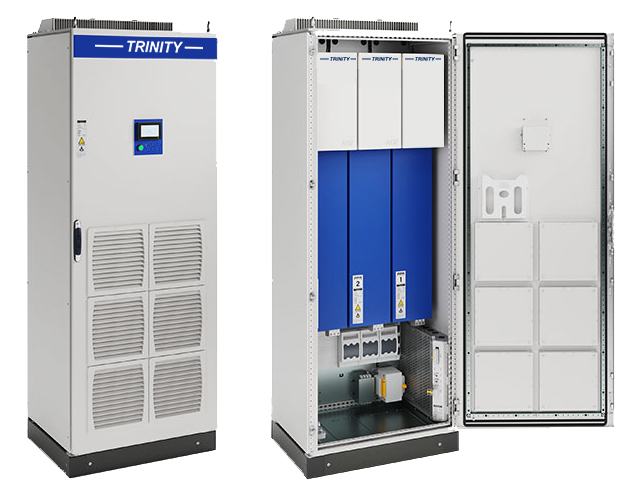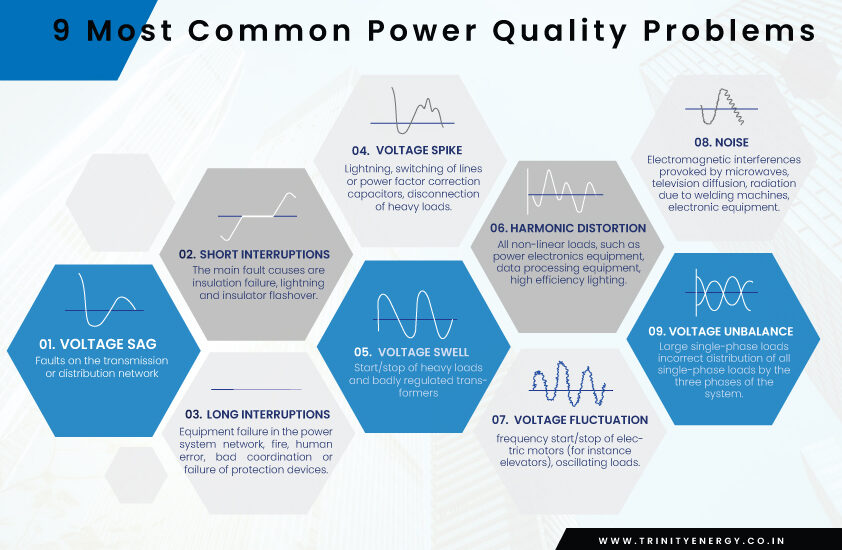Description, Causes, and Consequences
1. Voltage Sag:
DESCRIPTION: A reduction of the normal voltage level between 10% and 90% of the insignificant RMS voltage at the power frequency, for durations of 0,5 cycles to 1 minute.
CAUSES: Faults on the transmission or distribution network (most of the time on parallel feeders). Burdens in consumer’s installation. Connection of heavy loads and start-up of large motors.
CONSEQUENCES: Malfunction of IT equipment, like microprocessor-based control systems (PCs, PLCs, ASDs, etc) that may lead to a process stoppage. Tripping of contactors and electromechanical relays.
2. Very Short Interruption
DESCRIPTION: Total interruption of electrical supply for the duration from a few milliseconds to 1 or 2 seconds.
CAUSES: Mostly due to the opening and automatic reclosure of protection devices to discharge a faulty section of the network. The main burden causes are insulator flashover, insulation failure, and lightning.
CONSEQUENCES: Tripping of protection devices, loss of information and fault of data processing equipment. Slowdown of sensitive equipment, such as PCs, PLCs, if that equipment is not ready to deal with this condition.
3. Long Interruptions
DESCRIPTION: Total interruption of electrical supply for a duration greater than 1 to 2 seconds.
CAUSES: Equipment failure in the power system network, striking lines or poles, fire, human error, bad coordination, or failure of protection devices.
CONSEQUENCES: Stoppage of all equipment.
4. Voltage Spike:
DESCRIPTION: Very fast discrepancy of the voltage value for durations from several microseconds to a few milliseconds. These variations may reach thousands of volts, even at low voltage.
CAUSES: Lightning, switching of lines or power factor correction capacitors, disconnection of heavy loads.
CONSEQUENCES: Destruction of components (particularly electronic components) and of insulation materials, data processing errors and electromagnetic interference, data loss.
5. Voltage Swell:
DESCRIPTION: Temporary increase of the voltage, at the power frequency, external the typical acceptances, with a period of more than one cycle and typically less than a few seconds.
CAUSES: Start/stop of extensive loads, critically dimensioned power sources, badly regulated transformers.
CONSEQUENCES: Data loss, flaming of lighting and screens, stoppage or damage of sensitive equipment, if the voltage values are too high.
6. Harmonic Distortion:
DESCRIPTION: The waveform parallels to the sum of different with different extent and phase, having frequencies that are multiples of power-system frequency.
CAUSES: Welding machines, rectifiers, and DC brush motor working above magnetic saturation.
CONSEQUENCES: Increased probability in the amount of reverberation, neutral overload in 3-phase systems, overheating of all cables and equipment, loss of productivity in electric machines, electromagnetic interference with communication systems, errors in measures when using average reading meters.
7. Harmonic Distortion:
DESCRIPTION: Oscillation of voltage value, amplitude modulated by a signal with a frequency of 0 to 30 Hz.
CAUSES: Arc furnaces, frequent start/stop of electric motors (for instance elevators), oscillating loads.
CONSEQUENCES: Most consequences are common to under voltages. The most perceptible consequence is the flickering of lighting and screens, giving the impression of unsteadiness of visual perception.
8. Noise:
DESCRIPTION: Overlaying of high-frequency signals on the waveform of the power-system frequency.
CAUSES: Electromagnetic interferences provoked by Hertzian waves such as microwaves, radiation due to welding machines, electronic equipment and television diffusion. Improper grounding may also be a cause.
CONSEQUENCES: Disturbances on sensitive electronic equipment, usually unhelpful. May cause data loss and data processing errors.
9. Voltage Unbalance:
DESCRIPTION: A voltage variation in a three-phase system in which the three voltage scales or the phase-angle differences between them are not equal.
CAUSES: Large single-phase loads incorrect supply distribution of all single-phase loads by the three phases of the organization.
CONSEQUENCES: Unbalanced systems suggest the existence of a negative sequence that is harmful to all three-phase loads. The most affected loads are three-phase induction machines.
TRINITY POWER QUALITY ANALYZER FOR POWER QUALITY SOLUTIONS.

Write to us- info@trinityenergy.co.in








